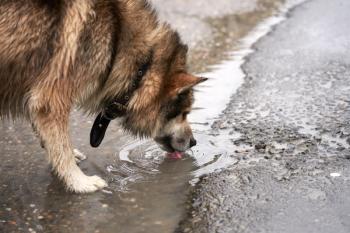
Aspiration Pneumonia in Pets and People
A recent review summarized what is currently known about aspiration pneumonia in dogs and humans.
Aspiration pneumonia (AP) commonly affects dogs. Although most dogs recover, up to 25% succumb to AP, highlighting the need for early diagnosis and treatment.
AP has been researched extensively in human and veterinary medicine. A review paper recently published in
Pathogenesis
In dogs, AP refers to aspiration pneumonitis (inflammation only) or true AP (inflammation + bacterial infection). AP-induced inflammation severity depends on aspirate volume, composition, and pH.
With tue AP, inflammation occurs through direct chemical burns with pneumonitis and bacterial colonization. Initially, alveolar macrophages and type II pneumocytes release cytokines that attract neutrophils. The neutrophils release toxins that increase endothelial permeability, leading to lung consolidation and reduced gas exchange.
RELATED:
- Antimicrobial Resistance in Pets: Are We Ignoring a Looming Threat?
- Macromolecules: Weapons in the Fight Against Antibiotic Resistance
Pulmonary surfactant, which lowers surface tension and enables easy breathing, is also affected by aspiration. Changes in surfactant composition increase surface tension, ultimately causing atelectasis and respiratory insufficiency.
Risk Factors
Dogs and humans have well-documented risk factors for AP. In dogs, the top 3 risk factors are esophageal disease (ie, megaesophagus), vomiting, and neurologic disease. Laryngeal disease, anesthesia, and breed are other risk factors. In general, the risk factors increase the likelihood of aspirating either large volumes, colonized material, or both.
For example, esophageal diseases facilitate regurgitation of esophageal contents that can reach the pharynx and be aspirated easily. Also, lower motor neuron diseases disrupt normal pharyngeal function. Brachycephalic breeds have a particularly high AP risk, given their anatomy and predisposition to chronic upper airway obstruction.
Diagnosis
AP diagnosis is typically presumptive rather than definitive and is frequently made using a dog’s history, clinical signs, and radiographic findings. Clinical signs are variable and nonspecific, but acute onset of respiratory distress is commonly observed. Previously unreported interstitial and alveolar patterns in the dependent lung lobes are the standard radiographic indicators of canine AP.
Other diagnostic tools for AP include oxygenation status, hematology, and bronchoalveolar lavage. On hematology, for example, an increased leukocyte count with a left shift may be present with AP.
Treatment
Supportive care and aggressive treatment of underlying predisposing factors are AP treatment mainstays. Unlike in human medicine, antibiotics are a frequent first-line therapy for canine AP, given the likelihood of colonized aspirate. Combination therapy with broad-spectrum antibiotics is often initiated without the benefit of culture and sensitivity testing.
IV fluids correct dehydration and restore normotension yet are administered cautiously in light of increased endothelial permeability. Oxygen therapy and nebulization with hypertonic saline are other supportive care measures for AP.
Bronchodilators and mucolytics are less commonly used for canine AP treatment. Steroids are no longer recommended because they have shown little benefit in improving lung function or overall outcome; in addition, their immunosuppressive effects and side effects can impede infection clearance and increase the risk of future aspirations.
Prognosis
Indicators of AP survival remain unclear, making prognosis difficult to determine. Human studies have identified negative prognostic factors, such as incorrect diagnosis and respiratory failure. Future veterinary studies will be needed to identify negative prognostic factors in dogs, the review’s authors wrote.
Prevention
AP prevention involves identifying at-risk patients and actively addressing underlying risk factors. For example, a dog with megaesophagus should be fed upright. Preventive measures for surgical procedures include minimizing anesthesia duration, properly inflating the endotracheal tube, and administering antacids and prokinetics.
Looking Forward
The authors noted the need for more veterinary research of AP, given that its characteristics are different and not always translatable between human and veterinary patients.
Dr. Pendergrass received her Doctor of Veterinary Medicine degree from the Virginia-Maryland College of Veterinary Medicine. Following veterinary school, she completed a postdoctoral fellowship at Emory University’s Yerkes National Primate Research Center. Dr. Pendergrass is the founder and owner of
Newsletter
From exam room tips to practice management insights, get trusted veterinary news delivered straight to your inbox—subscribe to dvm360.




